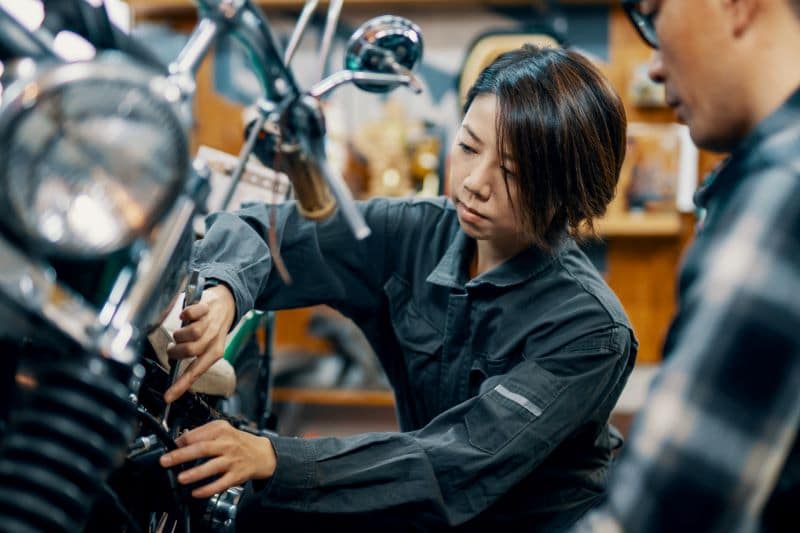Utah Motorcycle Safety And Maintenance Guide
Motorcycle safety and maintenance are important for all riders. Careful attention to safety and maintenance can save lives. If you or a loved one was injured in a motorcycle accident, our Utah motorcycle accident attorneys can help get compensation from a negligent motorcycle owner. Here is a list of tips for taking care of your bike.
Table of Contents
Motorcycle Safety Training
Confidence on a motorcycle takes practice. Begin by getting the proper license to be a rider. Motorcycle licenses are required for all those who wish to ride a motorcycle. The Utah DMV provides motorcyclist information that includes topics such as:
- Wearing the right gear
- Knowing your motorcycle
- Knowing your responsibilities
- Basic vehicle control
- Keeping your distance
- Situational awareness
- Handling intersections
- Making yourself seen
- Avoiding crashes
- Dangerous surfaces
- Mechanical problems
- Flying objects
- Passengers & cargo
- Earning your license
- Wear the proper gear: Wear all the gear, all the time.
- Helmet: Required for riders under age 21; recommended for everyone
- Visors and goggles: Eye protection shields you from wind, rain, insects, or dust
- Protective clothing: Clothing should be substantial and protect your shoulders, knees and elbows. The legs of your pants should cover the top of your shoe, preferably with leather or denim. Wear long sleeves or a jacket of durable material
- Gloves and gauntlets: Wear gloves. Full-fingered gloves are best.
- Motorcycle boots: Boots should be made of leather and cover the ankle bone.
- Ride unimpaired by alcohol or other drugs: Driving under the influence is against the law and extremely dangerous.
- Ride within your own skill limits: Know your limitations and act cautiously at all times when riding.
- Be a lifelong learner: You never stop learning when you’re a part of the motorcycling community. Pay attention to rule changes and take refresher rider courses to keep you up-to-date with safety and motorcycle improvements.
Motorcycle Maintenance Guide

Knowing your motorcycle and how to maintain it is very important for safety. If your bike is not running properly, you may encounter issues that could potentially lead to accidents down the road. Below is a list of recommendations for maintaining your ride.
- Follow the recommendations in your manuals: The motorcycle manufacturer wants you to know how to use and maintain your bike. Read it, study it, memorize it.
- Breaking in your bike: The most important miles on your bike are the first few hundred, then the next couple thousand. Ride gently as you break in your bike.
- Oil changes: Get regular oil changes. Oil ensures that your vehicle components don’t grind. If you ride in dirty or dusty areas, change it more often. Make sure you use the correct oil!
- Clean or change your air filter: Change your air filter about once a month. An air filter is important to the cylinders in your bike’s engine.
- Check your tire pressure: Making sure you have the correct air pressure in your tires will help the handling of your bike and your fuel consumption. Check your tire pressure once a week and add or drain as needed.
- Grease your bearings: All riders should keep their bike well lubricated. On some new bikes, the bearings are maintenance-free, but others need regular care. Even if you are consistent about greasing your bearings, eventually, they will need to be replaced. Check them regularly.
- Watch your drivetrain: Don’t forget your drivetrain—the chain, belt or shaft that transfers power from your transmission to your rear wheel. Depending on what type of final drivetrain you’re running, you’ll want to keep an eye on chain stretch, sprocket wear, belt cracking, and the oil in the shaft housing. Chain drive systems generally are the most maintenance-intensive.
- Check your battery terminal and wires: A new battery starts dying the second you start using it. The life of the battery depends on how well you keep it. Use a trickle charger to keep it charged while not in use.
- Get quality parts: When looking for parts to fix your bike, make sure to get great parts that will help your bike run smoother and won’t give you problems down the road.
You may think that your ride doesn’t need maintenance, but ultimately it saves money on costly repairs. Our attorneys for motorcycle accidents help those who have been injured in a motorcycle accident that was caused by another’s negligence or reckless behavior. Call us to discuss the compensation that you deserve for the pain and suffering you have endured.